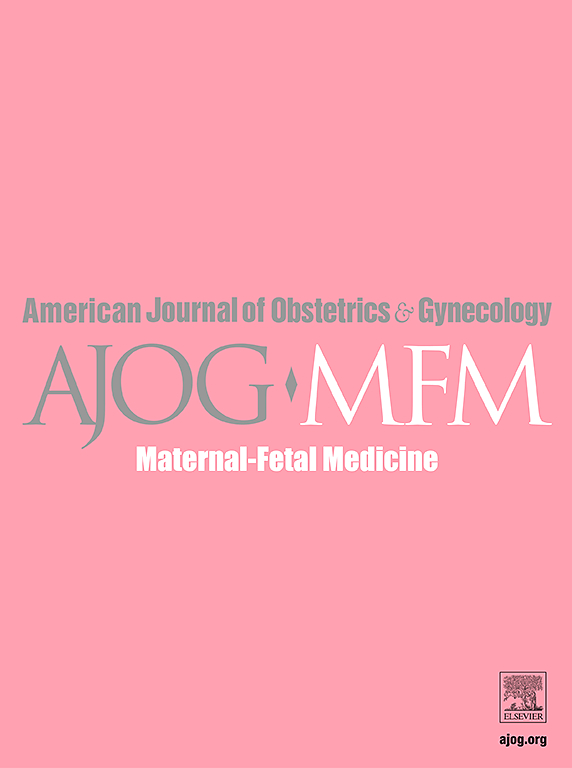Vaginal progesterone for prevention of preterm birth in women with a history of preterm birth regardless of cervical length: an argument for use
IF 3.8
2区 医学
Q1 OBSTETRICS & GYNECOLOGY
American Journal of Obstetrics & Gynecology Mfm
Pub Date : 2025-03-01
DOI:10.1016/j.ajogmf.2024.101565
引用次数: 0
Abstract
It is well understood that preterm birth accounts for a substantial amount of poor neonatal outcomes. In 2022, preterm birth affected about 1 of every 10 infants born in the United States with complications ranging from mild respiratory distress syndrome to neonatal death. The complexity of the treatment is secondary to the fact that preterm birth is a multifactorial syndrome with intricate sociocultural factors that influence our racially disproportionate poor outcomes. One of the key risk factors for preterm birth is a history of spontaneous preterm birth. Currently, there are conflicting recommendations regarding the use of vaginal progesterone prophylactically for the prevention of recurrent preterm birth. As described in Practice Bulletin number 234 of the American College of Obstetricians and Gynecologists, the current recommendation is that patients with a singleton pregnancy and previous spontaneous preterm birth should be assessed with serial endovaginal ultrasound cervical length measurements to determine eligibility for vaginal progesterone. In contrast, the Society for Maternal-Fetal Medicine suggests the use of prophylactic vaginal progesterone with patient-centered counseling and shared decision-making. We aimed to present the rationale for the use of prophylactic vaginal progesterone in patients with singleton gestations and a history of spontaneous preterm birth.
阴道黄体酮对有早产史的妇女预防早产的作用,与宫颈长度无关:使用的争论:争论。
众所周知,早产是造成新生儿预后不良的主要原因。2022年,在美国出生的每10名婴儿中就有1名患有早产,并发症从轻度呼吸窘迫综合征到新生儿死亡不等。治疗的复杂性是次要的,因为早产是一种多因素综合征,具有复杂的社会文化因素,这些因素影响着我们种族不成比例的不良后果。早产的关键危险因素之一是自发性早产的历史。目前,关于使用阴道孕酮预防复发性早产的建议存在矛盾。正如美国妇产科学会实践公报第234号所述,目前的建议是,单胎妊娠和既往自发性早产的患者应通过阴道内超声连续测量宫颈长度来评估,以确定阴道黄体酮的资格。相比之下,母胎医学协会建议在以患者为中心的咨询和共同决策的情况下使用预防性阴道黄体酮。我们的目的是提出在单胎妊娠和有自发性早产史的患者中使用预防性阴道孕酮的基本原理。
本文章由计算机程序翻译,如有差异,请以英文原文为准。
求助全文
约1分钟内获得全文
求助全文
来源期刊

American Journal of Obstetrics & Gynecology Mfm
Medicine-Medicine (all)
CiteScore
7.40
自引率
3.20%
发文量
254
审稿时长
40 days
期刊介绍:
The American Journal of Obstetrics and Gynecology (AJOG) is a highly esteemed publication with two companion titles. One of these is the American Journal of Obstetrics and Gynecology Maternal-Fetal Medicine (AJOG MFM), which is dedicated to the latest research in the field of maternal-fetal medicine, specifically concerning high-risk pregnancies. The journal encompasses a wide range of topics, including:
Maternal Complications: It addresses significant studies that have the potential to change clinical practice regarding complications faced by pregnant women.
Fetal Complications: The journal covers prenatal diagnosis, ultrasound, and genetic issues related to the fetus, providing insights into the management and care of fetal health.
Prenatal Care: It discusses the best practices in prenatal care to ensure the health and well-being of both the mother and the unborn child.
Intrapartum Care: It provides guidance on the care provided during the childbirth process, which is critical for the safety of both mother and baby.
Postpartum Issues: The journal also tackles issues that arise after childbirth, focusing on the postpartum period and its implications for maternal health. AJOG MFM serves as a reliable forum for peer-reviewed research, with a preference for randomized trials and meta-analyses. The goal is to equip researchers and clinicians with the most current information and evidence-based strategies to effectively manage high-risk pregnancies and to provide the best possible care for mothers and their unborn children.
 求助内容:
求助内容: 应助结果提醒方式:
应助结果提醒方式:


